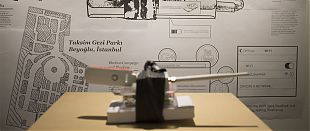An exhibition by Wachter and Jud
The first R! exhibition featured the work of Wachter and Jud, and ran from 4 November until 2 December 2017. The exhibition investigated how the digital communications society is also based on a world-view flourishing on exclusion and non-integration. The idea of a borderless and free exchange, which creates itself and even creates its own structures, has remained only an idea of art. Specific individual world views are lost at large in a communicative common world domain.
Artworks
qaul.net
In 2011, we launched qaul.net to explore our expression and communication options in the digital era. qaul.net is an independent open communications network and allows chat, voice calls, file sharing without Internet and mobile phones, directly in a spontaneous network of devices.
qaul.net implements a redundant, open communication principle, in which wireless-enabled computers and mobile devices can directly form a spontaneous network. Chat, twitter functions and movie streaming is possible independent of internet and cellular networks. qaul.net can spread like a virus, and an Open Source Community can modify it freely.
In a time of communication blackouts in places like Egypt, Burma, and Tibet, and given the large power outages often caused by natural disasters, qaul.net has taken on the challenge of critically examining existing communication pathways while simultaneously exploring new horizons.
Silent Protest
In September 2014, we received an email from a Chinese activist who wanted to organise an event in the public space in Beijing to which apply regulations and policing control. To circumvent the limitations, his event should take place on another layer to which participants in a wider range could join via their smartphones.
qaul.net was extended by a streaming server that allows a mutual sharing of audio messages in an open and independent network. With smartphones, sound be transmitted or received via WiFi connection.
“Can you hear me?”
About heard, listened to and isolated voices in the digital communication society.
Between the US Embassy and the British Embassy, Christoph Wachter and Mathias Jud have designed the art project “Can you hear me?”. Due to the revelations of Edward Snowden, this very place became a political focal point. From there, the British and the Americans were spying on the government and the people in Berlin.
Public protests went on without consequences. Instead, oppression became rather widespread. Ironically, the digital media means of expression that were considered, at the beginning of the Egyptian, Tunisian, or Turkish rebellions as promising tools were perverted into their opposite. The digital space which should allow democratic debate is fundamentally manipulated. Because of that, cultural, political, and communicative structures are also shaken and it leads to an experience not unlike the one experienced by people under authoritarian and restrictive regimes, where a gruelling dependence and speechlessness arises.
Monitored frequencies in Berlin are used to establish an open mesh network. Messages could be sent to the intelligence agencies on the frequencies that are intercepted by the NSA and GCHQ. Everybody – even the government officials and the officials of the intelligence agencies from the embassies at Pariser Platz – were invited to join the discussion. We have been excited to see what the world has to tell them.
Antenna Tower
Wi-Fi routers today build a very dense network. In most cities, it is common to find more than a dozen strong signals.
Connections between portable devices manage to bridge up to 250 metres. This distance can be augmented with sticks, routers and directional antennas such as the simple but effective can antennas.
A wooden tower with WLAN can antennas. From here, an open, independent wireless communication mesh network deploys. Customary routers are equipped with a customized open operating system and with improvised crafted
directional can antennas.
With these antennas and such towers, large distances can be bridged and the network can expand to large areas.
#GLM
#GLM [Grassroots Local Meshnet]
Video 26:00 Min. France 2013
Otherwise cut off from the Internet, a neighbourhood network connects an informal settlement in South Paris to the Internet with the help of can antennas and computers, March 2013.
Roma families build a gigantic antenna in an informal settlement in order to participate in the WLAN communications network #GLM [Grassroots Local Meshnet], Paris, 2013.
The bicycle is equipped with a mini- computer and numerous can antennas. Commands can be sent via a WLAN connection, for example, sending or checking e-mails or downloading music. If the bicycle is near an Internet hotspot, it dials in automatically and the commands are executed. The bicycle connects people in informal settlements with the Internet; Paris, 2013.
Gezi Park Edition
In 2014, we were invited to Istanbul as well as to the Asian part of the town, south of the Bosporus to give a series of workshops. People started building independent networks and connections on the basis of qaul.net.
Together with activists, we developed an extended version of qaul.net, based on their experiences from the Gezi Park protests.
We developed independent and mobile stations that can run even during power outages or network failures to allow local communication.These stations can be used for text messages, voice chats and file sharing. The Gezi Park Edition allows links to the Internet and other networks. Information can be exchanged over those interfaces even time-delayed. The local network also works as a kind of anonymization for the access to the Internet, as the devices cannot be identified by their IP addresses. Only random IP addresses are used within the network, and they are not registered. As a consequence the messages in the cloud cannot be prosecuted by authorities
This network is accessible for everyone, as a freely available and configurable open source software. Such networks can appear anywhere in manyfold variants and amounts. There is no central logging so to protect users.
The independent network remains available even after shut downs of web platforms, mobile services or Internet connections.
